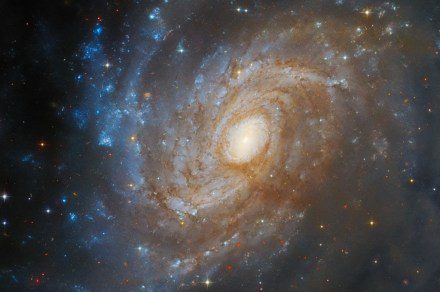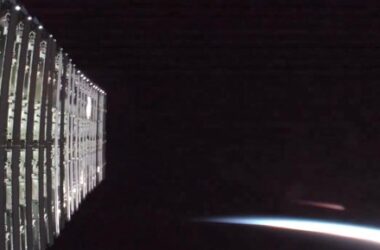A brand new picture from the Hubble Area Telescope reveals a galaxy partly hidden by an enormous cloud of mud often called a darkish nebula. The galaxy IC 4633 nonetheless shines brightly and fantastically in the principle a part of the picture, however to the underside proper, you’ll be able to see darkish smudges of mud which might be blocking the sunshine from this a part of the galaxy.
Taken utilizing Hubble’s Superior Digicam for Surveys (ACS) instrument, the picture additionally incorporates information from the DECam instrument on the Víctor M. Blanco 4-meter Telescope, which is positioned in Chile. By bringing collectively information from the space-based Hubble and the ground-based DECam, astronomers can get a greater have a look at this galaxy, positioned 100 million light-years away, and the darkish mud partially obscuring it.
The topic of this picture taken with the NASA/European Area Company Hubble Area Telescope is the spiral galaxy IC 4633, positioned 100 million light-years away from us within the constellation Apus. IC 4633 is a galaxy wealthy in star-forming exercise. It additionally hosts an energetic galactic nucleus at its core. From our viewpoint, the galaxy is tilted largely towards us, giving astronomers a reasonably good view of its billions of stars. ESA/Hubble & NASA, J. Dalcanton, Darkish Power Survey/DOE/FNAL/DECam/CTIO/NOIRLab/NSF/AURA; Acknowledgement: L. Shatz
This can be a bustling, busy galaxy, with vigorous star formation and a shiny middle known as an energetic galactic nucleus. Due to its orientation relative to Earth, we will see the elegant spiral form. Spiral galaxies are usually symmetrical, so you’ll be able to inform that the underside proper a part of the galaxy is being obscured by one thing as it’s so a lot much less shiny with stars than different elements.
The cloud of mud blocking the view is a part of a star-forming area known as Chamaeleon, and it’s a lot nearer to us than the galaxy it blocks. At simply 500 light-years away, the darkish nebula is far nearer to Earth than the galaxy.
When seen within the seen gentle portion of the spectrum, the identical wavelengths seen by the human eye and often known as the optical, these clouds of mud seem darkish and featureless. Certainly, for a few years, astronomers regarded such cosmic mud as nothing however an annoyance that obtained in the way in which of their observations. However in recent times, the significance of cosmic mud has change into obvious, because it performs a key position in processes like star formation.
Mud turns into much more attention-grabbing when it’s considered within the infrared wavelength, with devices like these used on the James Webb Area Telescope. Devices working within the infrared can peer by layers of mud to see buildings that may in any other case be hidden, corresponding to concentric mud shells round stars or the swirls of mud in close by galaxies.
Editors’ Suggestions









